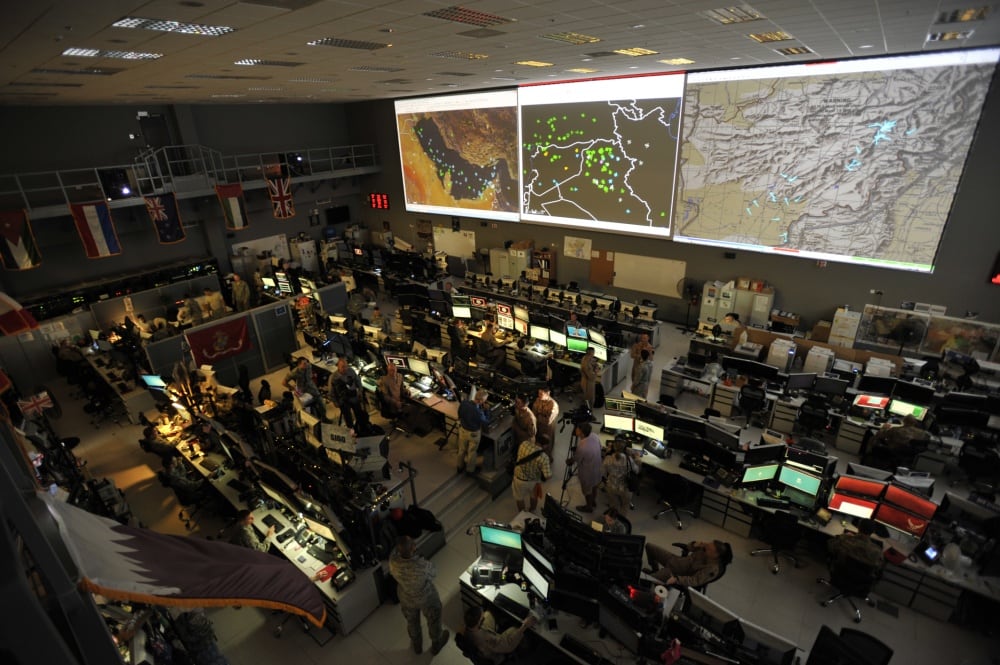The Air Force has begun a major overhaul of command-and-control systems across its 24 air and space operations centers.
The service is looking to upgrade the computers that control weapons systems; intelligence, surveillance and reconnaissance; and other key functions in the AOCs under a five-year, $375 million contract with Raytheon. The enhancements will enhance information sharing and integrate formerly disparate systems to improve usability.
“These systems literally were built almost in a vacuum. Each tool is designed to meet a very specific need,” said Jason Wiggins, who works with the Air Force Life Cycle Management Center and serves as the deputy program manager of the Air Operations Center-Weapon System. “It all has to be pulled together so people can make decisions as to how to best apply the air power at our disposal.”
The AOC serves as the central command-and-control node for air war combatant commanders. Its components include ISR, combat planning, combat operations, strategy and air mobility.

The operating concept for the AOC grew up from ad hoc efforts, and the service still struggles with that legacy. “The vast majority of these systems go back to Gulf War I, when individual units brought their own tools they gathered under a tent and shared information,” Wiggins said. “That has grown more cohesive, but it is still a series of stovepipes.”
Present solutions jury-rig connectivity between such elements as the Air Force’s theater battle management core system and master air-attack plan toolkit, space ISR assets, airborne sensor data, and a global command-and-control system managed by the Defense Information Systems Agency.
“We find ways to interface each of these different systems. We will set up a software bridge from one system to another to extract data back and forth,” Wiggins said.
AOC has a program office set up just to manage all these translations. “Right now we have to do this in order to get our ISR data fed to our main decision-makers,” he added.
With the upgrades, the Air Force wants to forge a more organic series of interconnections.
“The end vision, the goal to which the program office is aiming, is an integrated, seamless C2 weapons system. It has everything you need: Your inputs go in here, your outputs go out there, there is no more Frankenstein-ing a system together,” Wiggins said.
Raytheon says it can deliver this “without interruption to critical missions” by using software development best practices including Agile and DevOps, said Todd Probert, vice president of Mission Support & Modernization at Raytheon‘s intelligence, information and services division.
However, software processes alone won’t do it. The Air Force says it also considering infrastructure upgrades that would support a more seamless environment. Tools such as a service-oriented architecture and web-based platforms may come into play as a way to move the AOCs toward a more uniform, cloud-based design.
All this could have a direct impact on the ISR mission. Upgrades could enable more dynamic, time-sensitive targeting, something the Air Force is eager to achieve in the face of a fast-changing battle space. “These days, the turnaround time is in minutes,” Wiggins said. “We are breaking the stovepipes and widening the process by which that information is pulled in. We are going to be pulling in that raw data and we will have a fasted process by which it can be coalesced.”
Once that infrastructure is in place, the service plans to turn its attention to net-enabled weaponry and advanced multi-domain command and control.
With net-enabled weaponry, it might be possible for the AOCs to reprogram a missile in flight based on enhanced ISR data. Multi-domain C2 would enable the AOCs to share ISR data with allies while protecting sources of information.
All this would lead to a more combat-ready Air Force. “For the war fighter down range, seamless integration of data allows for faster reaction,” Wiggins said. “It allows for better data integrity to execute the mission. It also makes maintenance easier for the system administrators who have to take care of the system down range.”








